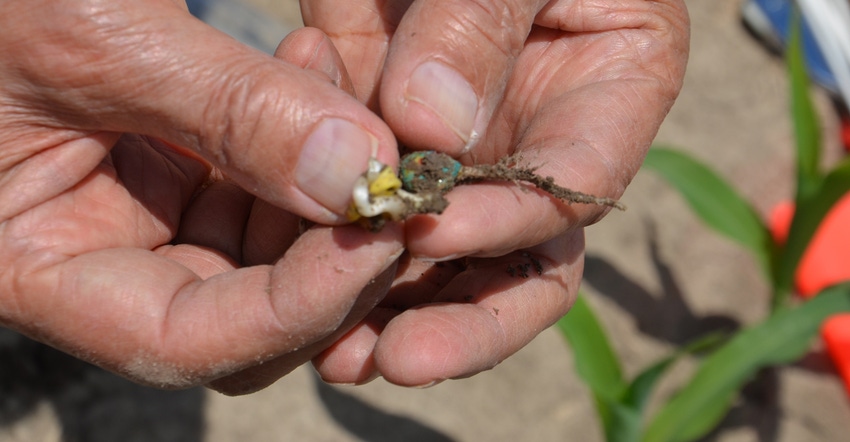
Dave Nanda dug carefully in a gap between two corn plants last spring. Did the planter fail to drop a seed there? Or did the seed fail to germinate?
Nanda is director of genetics for Seed Genetics Direct, Jeffersonville, Ohio. Seed Genetics Direct sponsors Corn Watch ’20. This feature examines what happens in a specific field in central Indiana and relates it to what could happen in your own fields.
What Nanda discovered was neither a skip nor an intact seed. Instead, the seed started germination, but then something caused the process to malfunction. Tissue emerging from the seed didn’t penetrate the soil surface.
“You can’t just assume a place where a plant is missing is a planter skip,” Nanda says. “You need to dig and see if a seed was planted or not. Germination isn’t 100% — not every seed will germinate. Then you get cases like this one where something went awry.”
Normal emergence process
Bob Nielsen, Purdue University Extension corn specialist, outlines how emergence should occur when germination and emergence function properly. “Elongation of the mesocotyl must elevate the coleoptile to the soil surface before the inner true leaves emerge from the protective tissue of the coleoptile,” he explains.
Growth stage VE, with E standing for emergence, is defined as the point at which the coleoptile and first true corn leaves come through the soil surface, he continues. The mesocotyl is the tubular, white, stem-like tissue which connects the seed and base of the coleoptile. Technically, it’s the first internode of the stem.
Once the coleoptile tip nears the surface, exposure to red light within solar radiation reduces production of the growth-promoting hormone from the coleoptile tip, Nielsen explains. That reduces the supply of the hormone in the mesocotyl, halting elongation.
The coleoptile itself is wrapped like inner leaves are wrapped or rolled up within the whorl. As true inner leaves expand, they force the coleoptile to partially unwrap near the tip, letting the first true leaves emerge. If the mesocotyl successfully elevated the coleoptile tip to the surface, the first true leaves appear just above the soil surface.
It isn’t magic, but it is a work of natural beauty! To learn more, read The Emergence Process in Corn at the Chat ’n Chew Cafe.
3 useful tips about corn emergence
Here are three concepts to keep in mind about corn seeding and emergence:
1. Mesocotyls can handle 6-inch depth. Mesocotyls are believed to be physiologically capable of elongating successfully from a 6-inch planting depth, Nielsen says. So, realistically, corn can be planted at least 3 inches deep, if necessary to reach adequate moisture, and emerge successfully.
2. Seeding too shallow hurts nodal roots. If seed is placed less than one-half inch deep, the crown of the coleoptile will be near or at the soil surface. When nodal roots develop, they may be restricted by exposure to high temperatures and dry soil.
3. Check health of the mesocotyl. The mesocotyl — the connection from the seed to the stem — should remain firm, white and healthy through at least the 6-leaf stage of corn growth, or V6. If it�’s mushy, discolored or damaged before V6, it may hold clues to whatever crop problem you’re investigating.
About the Author(s)
You May Also Like




